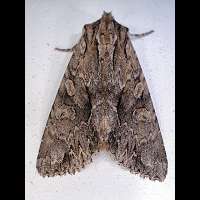Dark Arches Apamea monoglypha
Dark Arches is quite a big species among the arches. The wingspan may be up to 55 mm. Usually light brown to grey brown, but melanism occurs, producing very dark animals. Usually quite unmistakable by the big W-shaped marking near the tip of the wing, even in very dark animals.
The eggs are being deposited in summer and hatch within a fortnight. Young small caterpillars feed on flowers or seeds of the host plant. Later they move downwards and eat the roots and the stem of the hostplant. Only feeding at night, they hide in a hollow among roots during the day. They even overwinter in this hollow and don't pupate till May or June next year. Pupation takes a relatively short period of time, for after 3 to 5 weeks the adult moths appear. Fullgrown larvae of the Dark Arches are thick, rather ugly caterpillars. They are whitish brown, rather glassy with a lot of shiny black spots. They look like the caterpillars of other Apamea species, but are bigger, reaching a length of some 45 mm. Full grown larvae live near the roots and stems of various grasses, such as cock's foot, even in cities.
Dark Arches is on the wing early in dusk and is then seen feeding on garden plants, such as valerian and buddleia. Readily comes to sugar and light as well. Rests during the day in low vegetation, on tree trunks, fences and poles. A very common species all over Britain and commonly seen in parks and gardens. On the wing from May to October, but great numbers only appear in June and July. Animals seen in August and September in Southern Britain are probably the result of a very small second generation. Common species all over the continent as well.
Dark Arches is quite a big species among the arches. The wingspan may be up to 55 mm. Usually light brown to grey brown, but melanism occurs, producing very dark animals. Usually quite unmistakable by the big W-shaped marking near the tip of the wing, even in very dark animals.
The eggs are being deposited in summer and hatch within a fortnight. Young small caterpillars feed on flowers or seeds of the host plant. Later they move downwards and eat the roots and the stem of the hostplant. Only feeding at night, they hide in a hollow among roots during the day. They even overwinter in this hollow and don't pupate till May or June next year. Pupation takes a relatively short period of time, for after 3 to 5 weeks the adult moths appear. Fullgrown larvae of the Dark Arches are thick, rather ugly caterpillars. They are whitish brown, rather glassy with a lot of shiny black spots. They look like the caterpillars of other Apamea species, but are bigger, reaching a length of some 45 mm. Full grown larvae live near the roots and stems of various grasses, such as cock's foot, even in cities.
Dark Arches is on the wing early in dusk and is then seen feeding on garden plants, such as valerian and buddleia. Readily comes to sugar and light as well. Rests during the day in low vegetation, on tree trunks, fences and poles. A very common species all over Britain and commonly seen in parks and gardens. On the wing from May to October, but great numbers only appear in June and July. Animals seen in August and September in Southern Britain are probably the result of a very small second generation. Common species all over the continent as well.




